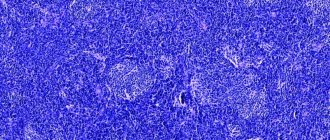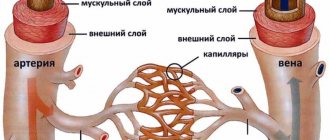Causes of fatigue and apathy
- Hormonal imbalance, namely decreased activity of the thyroid gland (hypothyroidism). Thyroid hormones are natural energy boosters. They speed up metabolism, regulate the functioning of the reproductive and digestive systems, and affect the central nervous system. In addition, patients experience swelling, constipation, excess weight, menstrual and sexual dysfunction. With hypothyroidism, you may feel constantly drowsy and tired, feel cold and have difficulty withstanding the cold. You may feel as if your body is going into hibernation. In addition, it is possible to gain excess weight if your diet remains unchanged. This pathology is mainly encountered by women over 40 years of age.
- Anemia or anemia. With this disease, the amount of hemoglobin and the number of red blood cells decrease. Oxygen starvation occurs, tissues “suffocate,” and body functions are disrupted. This results in constant fatigue; you feel exhausted even after proper rest. The slightest physical activity causes rapid heartbeat, chest pain, and a feeling of shortness of breath. Hair falls out more than usual and nails break.
- Internal illnesses. Most often, apathy and drowsiness are observed when the functioning of the following organs is disrupted: kidneys, liver, heart and blood vessels, and digestive tract.
- Menopause. During menopause, the production of sex hormones decreases, hot flashes, depression, insomnia occur, headaches may occur, and excess weight may be gained with the same diet. Almost all women during menopause note a decrease in performance, constant fatigue and irritability.
- Depression, chronic fatigue syndrome and other pathologies.
If fatigue haunts you constantly, you should check your health, because this could be a symptom of an illness. See the video for more details.
Chronic fatigue syndrome - symptoms and treatment
The intensive development of the information and social environment negatively affects the psychophysical state of a person, thereby provoking diseases previously unknown to science. One such disorder is chronic fatigue syndrome —a feeling of constant overwork.
The World Health Organization does not recognize this condition as a disease, however, the current International Classification of Diseases (ICD-10) contains similar symptoms, “Fatigue syndrome after a viral illness” (disease code - G93.3).[1]
Epidemiology
The prevalence of chronic fatigue syndrome among adults is 0.006–3%, but approximately 80% of all cases remain undiagnosed. The peak incidence of chronic fatigue syndrome occurs at the active age of 40–59 years. Women in all age categories are more susceptible to this disease and make up 60–85% of all cases [11].
Risk factors
Most often, chronic fatigue syndrome occurs in residents of megacities, since their rhythm of life and field of activity require constant psycho-emotional stress and multitasking. The risk group includes people who are engaged in professional growth, creating and supporting a family, solving many everyday issues, active relationships in society, and also bear an increased level of professional responsibility. All these factors lead to unbearable psycho-emotional stress and, as a consequence, nervous disorders and physical ailments - this is the stress-dependent hypothesis for the development of chronic fatigue syndrome.
A distinctive feature of chronic fatigue syndrome is the persistence of its main symptoms even after a long rest: neither a short-term change in activity nor departure from usual responsibilities can eliminate the root of the problem.
Etiology
The causes of the syndrome can be:
- unsatisfactory quality of lifestyle - intense daily rhythm, irrational time planning, prolonged mental or physical activity without breaks and rest (including lack of proper sleep, walks in the fresh air and change of environment);
- malnutrition - a lack of a balanced diet that includes vitamins and minerals that are essential for maintaining mental capacity, physical activity and emotional stability;
- diseases and ailments - chronic diseases, including psychological disorders, deplete the body’s resources, reducing its ability to recover and withstand stress;
- poor environmental conditions - a harmful environmental situation creates an unfavorable background for normal human life, therefore high levels of pollution and noise in cities lead to an increase in the number of the syndrome.
Prevention of chronic fatigue, apathy, loss of strength
First of all, you should cultivate a culture of health. From a young age, strengthen the body with a healthy lifestyle, adhere to the following rules.
- Physical exercise. Take the habit of running in the morning, doing exercises, and walking as much as possible. Do you live on the 5th floor? Forget the elevator. Are you going to go to the store next door? Give preference to walking. The main enemy of women prone to blues and depression is the sofa, the TV and a bag of sweets to boot.
- Proper nutrition. An unbalanced diet, snacks on the go, and junk food are a real danger of gaining excess weight, which will also lead to depression. Avoid sweets, fried foods, and fast carbohydrates. Lightness in the body - lightness in the soul.
- Rejection of bad habits. The dubious pleasure of cigarettes and alcohol and the harm from them are incomparable.
- Minimize stress. Not everyone has the opportunity to change a job they don’t like, set boundaries for what is permitted, or improve family relationships. But try to minimize negative emotions in your life. Stress is the main enemy of your health.
Fatigue and its manifestations
There is a lack of awareness among doctors about this mental disorder, the least specific of all, and there is no general understanding of the reasons for its occurrence. A variety of symptoms that are strictly specific to each case of the development of one or another form of fatigue are not monitored.
Manifestations of fatigue in each individual case can be defined as basic or initial in relation to any other disorders, sometimes preceding or determining and almost always completing the course of any disease - somatic or mental, which also increases the significance of this problem [6–8].
The polymorphism of symptoms leads to the identification of various syndromes and diseases, such as asthenic syndrome, chronic fatigue syndrome, vegetative-vascular dystonia, nervous weakness, asthenic condition, neurotic syndrome, neurasthenic reaction, neurotic condition, pseudoneurasthenia, functional disease of the nervous system, neurasthenia, etc. [9, 10].
The symptoms of the disorder are varied [11, 12] and vary greatly depending on the reasons that caused fatigue or the disease against which it developed. But as already mentioned, there are a number of clinical manifestations and characteristic groups of symptoms that are present in all cases of the development of fatigue to a greater or lesser extent:
1. Weakness:
- a feeling of physical and mental fatigue, fatigue, which limits performance and often occurs before work (should be distinguished from physiological fatigue and tiredness);
- inability to exert stress for a long time and rapid exhaustion, leading to a deterioration in the quality of work;
- a feeling of powerlessness, adynamia, inability to remember, creativity, which is accompanied by tears and despair;
- feeling of lethargy, weakness, difficulty thinking, loss of associations, lack of thoughts, feeling of emptiness in the head, decreased activity and interest in others;
- drowsiness combined with constant mental and physical fatigue;
- increased mental and physical exhaustion with sudden sweating, tremors after a conflict or excitement.
2. Irritability:
- anger;
- explosiveness;
- increased excitability;
- grumpy touchiness;
- pickiness;
- grumpiness;
- vulnerability for no reason;
- internal anxiety;
- restless activity;
- inability to rest;
- sensitivity with tears;
- dissatisfaction for any reason and without an obvious reason.
3. Sleep disorders:
- difficulty falling asleep;
- manifestations of unusually persistent insomnia or sleep “without the feeling of sleep,” when the patient resolutely denies reports from staff that he was sleeping;
- sensitive, restless sleep, lack of performance after sleep;
- waking up early with a feeling of unaccountable anxiety, internal restlessness and impending unhappiness;
- perversion of the “sleep formula”: drowsiness during the day, insomnia at night;
- constant desire for sleep and drowsiness.
4. Autonomic disorders:
- various types of vascular disorders: fluctuations in blood pressure, pulse and slight paleness or redness of the skin during excitement; vascular asymmetry (different pressure on the arms); discomfort in the heart area; stabbing pain and palpitations; changes in vascular reflexes; asymmetry of body temperature; sweating of various parts of the body;
- headache, most often occurring with fatigue, excitement, at the end of the working day, often of a tightening nature, characterized by patients as “a neurasthenic helmet”, “as if a hoop was put on the head”;
- Severe headaches are not uncommon, occurring more often at night and in the morning, the patient may wake up because of them; the pain is bursting in nature;
- dizziness and heaviness in the head;
- changes in muscle tone;
- impaired potency, dysmenorrhea in women;
- gastrointestinal disorders;
- allergic reactions;
- cognitive dysfunction.
Physiological fatigue can develop against the background of ordinary fatigue from physical or psychological stress. As a rule, doctors are not consulted about this - unlike the situation when it comes to the development of a psychopathological symptom complex against the background of a neurological, somatic or mental disorder, in particular asthenia or chronic fatigue syndrome.
Asthenia (Greek astheneia - weakness, impotence) is a psychopathological disorder, the picture of which is determined by the phenomena of increased physical and/or mental fatigue with a decrease in the level of activity (lack of vigor, energy, motivation), entailing clinically and socially significant consequences: the need for additional rest, a decrease in the volume and efficiency of activities (even habitual ones) [4, 13–15].
There are a number of clinical forms of asthenia. The most common forms are:
1. Hypersthenic form.
It is characterized by a weakening of the processes of internal inhibition, as a result, irritative symptoms come to the fore: phenomena of irritability, increased excitability, anger, incontinence, impatience. Patients complain of a constant feeling of internal tension, anxiety, inability to restrain themselves, to wait. The feeling of fatigue, especially noticeable during failures, is sharply replaced by an increase in performance with successful results. Fatigue itself has a peculiar character; they say about it: “fatigue that knows no rest.” Despite the feeling of fatigue, the patient is restless and is constantly doing something.
Sleep is characterized by nightmares, inability to fall asleep, lack of a refreshing effect and the presence of feelings of anxiety and irritability.
Autonomic disorders: increased sweating, tachycardia, increased blood pressure.
2. Hyposthenic form (often called wasting syndrome).
It is characterized by the development of protective inhibition and a decrease in cortical excitability. In this regard, the phenomena of general weakness, exhaustion and fatigue come to the fore. Habitual activities cause great stress in such patients. By the middle of the day they are unable to work normally, and after work they feel completely unable to do anything, have fun or read. Characterized by constant drowsiness. The mood is low and has a hint of apathy. Sometimes, against the background of this nervous and physical impotence, short-term irritation arises about one’s own unproductivity and clashes with others, after which even greater fatigue and adynamia are noted, accompanied by tears.
There are special forms: the first is intermediate between the above, the second is the result of the development of asthenia.
3. Irritable weakness syndrome.
The phenomena of increased irritability, excitability with fatigue, weakness, and exhaustion come to the fore. These are those patients in whom short outbursts of anger are followed by tears and weakness; after a rapid start to activity there is a rapid decline in performance; behind the quickly flared up interest there is lethargy and apathy; behind the impatient desire to say or do something is a subsequent feeling of fatigue and powerlessness.
4. Astheno-vegetative and astheno-hypochondriacal form.
It is characterized by a predominance of vegetative disorders. In patients from the very beginning or, more often, after a relatively short debut of general asthenic disorders, objective and subjective symptoms of various disorders characterized by polymorphism, variability, and turnover appear quite clearly. Patients describe their condition as follows: “everything hurts: my heart is pounding and beating, I’m sweating, I’m losing weight, I have no appetite, there’s heaviness in my stomach, belching of food, diarrhea is replaced by constipation, hives on the skin.”
Hypochondria is characterized by anxious fears. Cancerophobia, fear of missing a disease, fear of a heart attack, etc. arise. The patient retains a critical attitude towards these fears, he tries to fight them, and can be persuaded. Often occurs or intensifies after the occurrence of a real somato-vegetative disorder.
In the International Classification of Diseases, 10th revision, conditions, the main manifestation of which is asthenia, are considered under the headings:
1. Neurasthenia F48.0.
2. Organic emotionally labile (asthenic) disorder F06.6.
3. Fatigue syndrome after viral infection G93.3.
4. Asthenia NOS (R53) (unspecified).
5. Overwork (Z73.0) (burnout syndrome).
6. Other specified neurotic disorders (F48.8), which includes psychasthenia.
Currently, in practice it is customary to distinguish the following clinical and etiological forms of the disease:
1. Exogenous-organic:
- functional (somatogenic) asthenia;
- organic (cerebrogenic) asthenia.
2. Psychogenic-reactive asthenia:
- overload syndrome;
- neurasthenia.
3. Constitutional asthenia.
4. Asthenic depression.
5. Endogenous asthenia (schizophrenic asthenia).
6. Asthenia due to non-medical use of psychoactive substances.
Functional asthenia (somatogenic) is an independent clinical unit that is not associated with specific organic diseases [15, 16]. It is characterized primarily by clinical reversibility, since it arises as a result of or as a component of time-limited or curable pathological conditions. These include:
1) acute asthenia, which occurs as a reaction to acute stress or significant overload at work (mental or physical (overexertion asthenia);
2) chronic asthenia, appearing after childbirth (postpartum asthenia), infections (post-infectious asthenia) or noted in the structure of withdrawal syndrome, cachexia, etc.;
3) separately, due to the extreme significance of the problem, psychiatric asthenia is distinguished, in which an asthenic symptom complex is identified in the structure of functional borderline mental disorders (anxiety, depression, insomnia, etc.).
Organic asthenia (symptomatic, neurosis-like) is a condition characterized by severe and persistent emotional incontinence or lability, fatigue, or a variety of unpleasant physical sensations (for example, dizziness) and pain, presumably arising from an organic disorder. The disorder is thought to be more often associated with cerebrovascular disease or hypertension than with other causes. It also occurs as a result of various somatic diseases, being their manifestation.
Neurasthenia is one of the psychogenic diseases that occurs after acute or long-term psychogenic stress.
Neurasthenia is characterized by:
- decreased physical activity: unusual fatigue during the day with weakening or loss of the ability to exercise for more or less prolonged periods, combined with an increased need for rest and lack of a feeling of full recovery after rest;
- phenomena of irritable weakness in the form of increased excitability and exhaustion quickly following it;
- intolerance to psycho-emotional stress (lability of mood with the inability to restrain reactions of resentment, outbursts of irritability and discontent, followed by violent remorse);
- cognitive disorders: increased fatigue even under normal intellectual stress with decreased concentration and executive functions (absent-mindedness, difficulty in concentrating for long periods of time, decreased volume and efficiency of activity);
- disturbance of the sleep-wake cycle: episodes of drowsiness during the day or fluctuating drowsiness throughout the day combined with deterioration in sleep quality (insomnia is manifested by shallow intermittent sleep with unpleasant, often anxious, dreams or drowsy states).
Overload syndrome is characterized by clinical manifestations very similar to neurasthenia (fatigue, decreased physical activity, fatigue, emotional instability, irritability, sleep disorders).
Constitutional asthenia is manifested by hyposthenia. Symptomatic lability characteristic of patients is due to congenital inferiority of vegetative functions (vascular crises, dizziness, orthostatic fainting, palpitations, hyperhidrosis, etc.) and hypersenesthesia in the sphere of bodily perception (hyperpathy, algia, pseudomigraine).
Constitutional asthenics [K. Schneider, 1928] are characterized by an elegant physique with a predominance of longitudinal dimensions over transverse ones (“Gothic” body type), hypoplasticity of the cardiovascular system (drop-shaped heart, narrowing of the aorta, tendency to syncope), infantilism of the genital area. They are timid, passive, cannot tolerate even minor emotional stress, get tired quickly, get upset over any trifle and, losing self-control, become unrestrained. Increased impressionability and suspiciousness are often combined with a consciousness of their own inferiority. Their character and behavior bear the imprint of weakness and instability.
Asthenic depression. The course of such depression is slow, with an imperceptible onset, or persistent wave-like (like dysthymia). Less commonly observed is a recurrent course with deterioration of the condition due to increased asthenic and autonomic disorders. The clinical picture includes depressed mood, but hypothymia is not accompanied by feelings of melancholy and hopelessness characteristic of endogenous depression. The peak of poor health in the morning is also not associated with vital symptoms of depression, and ideas of low value and guilt are not typical. Disorders of the sleep-wake cycle are less pronounced than in somatogenic asthenia, in which manifestations of hypersomnia predominate; in these cases, pre-, intra- and post-somnic disorders (disturbances in the depth of sleep) are most pronounced. Sadness and heaviness in the soul are interpreted as a consequence of poor physical health or unfavorable life events, and fluctuations in depressive affect are associated with changes in the situation. Weakness with decreased activity and initiative, and increased tearfulness (“tears flow by themselves”) predominate. The picture of full-blown asthenic depression is determined by signs of negative affectivity and includes increased exhaustion, complaints of physical impotence, loss of energy, “wear and tear,” and disproportion of sensations accompanying physiological processes.
Endogenous asthenia (schizophrenic, asthenic-like). Asthenic manifestations in such cases are realized in accordance with the stage of the endogenous process and can, in some cases, determine the structure of psychopathological disorders at each of these stages separately, ending with a complete change in the syndrome (residual conditions, in the picture of which negative disorders dominate, are an exception). In all other cases, a different evolution of the syndrome is characteristic. In sluggish schizophrenia with a predominance of asthenic disorders, asthenia prevails throughout the entire course of the disease:
1. At the prodromal stage, the phenomena of hyperesthetic asthenia predominate: a painful feeling of fatigue, signs of sensitization to normally neutral stimuli, hyperpathia, sleep disturbances.
2. At the onset of the disease process (as a rule, it occurs in adolescence), the clinical picture is determined by the phenomena of juvenile asthenic failure, often overlapping with affective (depressive) disorders. Among the manifestations of the disease is a progressive decline in academic performance, which is most pronounced during exam sessions: severe mental fatigue, absent-mindedness, decreased concentration. In this case, complaints of nervous exhaustion, weakness, poor memory, absent-mindedness and difficulties in comprehending the material predominate.
3. In the active period of the disease (manifest stage), the symptoms of asthenia, not associated with mental or physical overload, prevail and occur with the alienation of self-awareness of activity. Asthenia acquires a total character, the feeling of a decrease in activity covers both the ideational and somatopsychic spheres (vital asthenia syndrome). In some cases, the phenomena of physical impotence take the form of a violation of the general sense of the body. The clinical picture is dominated by weakness, weakness, a feeling of loss of muscle tone, unusual physical heaviness, and “wooliness” throughout the body. The course of schizoasthenia, as a rule, takes on a continuous character. In this case, exacerbations are possible in the form of affective phases, occurring with increased mental and physical asthenia, depressed, gloomy mood, anhedonia and alienation phenomena (a feeling of indifference, detachment from the environment, inability to experience joy, pleasure and interest in life). The picture of remissions is dominated by the symptomatology of the same name, associated with hypochondriacal introspection and fear of exacerbations - dyspsychophobia.
4. At the final stages of the process (stabilization period, residual conditions), a persistent asthenic defect is formed. In the clinical picture, the phenomena of asthenia again come to the fore, but in the form of negative changes. The latter are manifested both by disorders of the cognitive sphere (persistent mental fatigue associated with difficulties in comprehending what has been read and memory disorders) and changes in the general feeling of the body (feelings of unusual physical heaviness, loss of muscle tone, general impotence).
Asthenic disorders that deepen within a series of negative changes take the form of somatopsychic fragility. Even minor physical stress or psycho-emotional stress (watching a movie, communicating with relatives) is accompanied by an increase in the intensity of asthenic disorders: weakness, lethargy, a feeling of exhaustion, heaviness in the head, a feeling of tightness in the back of the head, heightened sensitivity to the slightest changes in the established life pattern. The formation of negative disorders is accompanied by a steady decline in performance. Due to fears of worsening well-being (increased lethargy, headaches, insomnia), patients minimize work duties and household chores, shifting most of the household chores to loved ones, and refuse to communicate.
Asthenia due to non-medical substance use occurs in adolescents and adults with all forms of substance dependence. The most severe conditions are observed when using psychostimulants (so-called “disco drugs”). In this case, the typical asthenic symptoms are accompanied by a feeling of exhaustion with aching pain in different parts of the body. The need for sleep is combined with the inability to fall asleep, and drowsiness is combined with restless sleep. Characteristic emotional disturbances: dysphoria, anger, suspicion. With continued abuse of psychoactive drugs, serious, prolonged depression develops.
The term “chronic fatigue syndrome” appeared in 1984 in the USA [17, 18]. Whether this syndrome is independent in relation to asthenia or a separate manifestation of asthenic disorders is a debatable issue to date. It is believed that chronic fatigue syndrome affects patients who experience debilitating fatigue (or get tired quickly) for at least six months, and whose performance has decreased by at least half [19, 20]. In this case, any mental illnesses should be excluded (with the help of doctors), such as depression, which has similar symptoms, various infectious diseases, hormonal disorders, for example those associated with dysfunction of the thyroid gland, drug abuse, exposure to toxic substances. To make a diagnosis, a combination of 2 major and 8 of 11 minor symptoms is required, constantly or recurring over 6 months. or longer. Today, about 17 million people worldwide suffer from chronic fatigue. Thus, in the United States there are from 400 thousand to 9 million adults with this disease. This disorder is recorded in environmentally unfavorable regions where there is a high level of environmental pollution with chemically harmful substances or increased levels of radiation.
Currently, there are several theories about the development of chronic fatigue syndrome. The most common belief is that chronic fatigue is caused by a deficiency of the immune system or a chronic viral infection. This is due to the fact that patients with this pathology show signs of decreased immunity.
To summarize, it must be said that ordinary fatigue, with insufficient attention to it, can turn into overwork, and then into asthenia as a significant but nonspecific syndrome for the patient. In all cases, the doctor must respond to this by prescribing certain schemes for correcting the patient’s condition.
Treatment
Non-drug treatment is aimed at activating the metabolism and restorative functions of the body, normalizing the work and rest regime. Physical therapy, physiotherapeutic procedures, and sanatorium-resort treatment are often used [4, 21]. The most effective approach is psychotherapy. This is, first of all, the rational conviction of the patient in the absence of serious diseases, the formation of a positive attitude, auto-training - reducing the intensity of existing manifestations of neurotic symptoms, person-oriented (reconstructive) psychotherapy - the formation of a healthy lifestyle.
Herbal preparations (otherwise known as galenic preparations) are a group of pharmaceuticals and dosage forms obtained, as a rule, from plant materials by extraction. It is known that herbal medicines (ginseng, Aralia Manchurian, golden root, Chinese magnolia vine, Sterculia platanofolia, Eleutherococcus senticosus, etc.) restore neurohormonal regulatory mechanisms and optimize recovery processes in severe, recurrent chronic diseases, reduce the risk and rate of development of degenerative-dystrophic diseases. and precancerous diseases, have a number of advantages regarding safety, namely their non-toxicity and compatibility with other drugs, and can be used by weakened patients [22]. In some cases, hypersensitivity reactions (allergic skin reactions) may occur, as well as cases of allergic reactions due to individual sensitivity to the components of the drugs (phenol, quinine), increased blood pressure (hypertension), tachycardia, conditions that are accompanied by overexcitation and hyperkinetic syndrome.
An equally interesting drug from the point of view of treating asthenia is the extract of red deer antlers. This extract is highly effective due to the high concentration of a complex of biologically active substances. It contains more than 80 different elements: peptides, amino acids, lipids, carbohydrates, nucleotides, minerals, glucosides, vitamins. The extract is a valuable source of essential amino acids, which must enter the human body with food, and contains protein with collagen. Amino acids are the most important components of proteins, enzymes and other biological substances; they also have an independent preventive value. Glutamic acid takes part in the biological processes of the brain, in protein and carbohydrate metabolism, and improves the nutrition of brain cells. Aspartic acid is used in the prevention and treatment of diseases of the cardiovascular system, promotes the penetration of potassium and magnesium ions into the intracellular space. A mixture of methionine, cysteine, glutathione and adenosine triphosphate (ATP) improves the biosynthesis of protein and nucleic acids by providing energy to these processes. The extract can be used in patients with fatigue, asthenic conditions of various natures, and also for preventive purposes as a tonic and stimulant during increased physical and mental stress.
You can use preparations of St. John's wort, which has a mild anxiolytic (eliminates feelings of fear and tension) and antidepressant (eliminates depression and apathy) effect, increases mental and physical activity, and normalizes sleep. Valerian root has a multifaceted effect on the body, depresses the central nervous system (CNS), reduces its excitability, and facilitates the onset of natural sleep.
Nootropics (Greek noos - thinking, mind; tropos - direction) are drugs that have a specific positive effect on the higher integrative functions of the brain. They improve mental activity, stimulate cognitive functions, learning and memory, and increase the brain’s resistance to various damaging factors, including extreme stress and hypoxia. In addition, nootropics have the ability to reduce neurological deficits and improve cortico-subcortical connections.
Currently, the main mechanisms of action of nootropic drugs are considered to be the influence on metabolic and bioenergetic processes in the nerve cell and interaction with the neurotransmitter systems of the brain. Neurometabolic stimulants improve the metabolism of nucleic acids, activate the synthesis of ATP, protein and ribonucleic acid (RNA). The effect of a number of nootropics is mediated through the neurotransmitter systems of the brain, among which the most important are monoaminergic (piracetam causes an increase in the content of dopamine and norepinephrine in the brain, some other nootropics - serotonin), cholinergic (piracetam and meclofenoxate increase the content of acetylcholine in synaptic endings and the density of cholinergic receptors , choline alfoscerate, pyridoxine and pyrrolidine derivatives improve cholinergic transmission in the central nervous system), glutamatergic (memantine and glycine act through N-methyl-D-aspartate (NMDA) receptor subtype).
There is a group of antiasthenic drugs – deanol aceglumate, salbutiamine, etc. [23, 24].
Deanol aceglumate has a structural similarity to γ-aminobutyric and glutamic acids, is a neurometabolic stimulant, has cerebroprotective, nootropic, psychostimulating and psychoharmonizing effects, facilitates the processes of fixation, consolidation and reproduction of information, improves learning ability. Deanol aceglumate is successfully used in the treatment of asthenic disorders (borderline conditions, psychoorganic syndrome, schizophrenia, alcoholism), neuroleptic syndrome (mild and moderate manifestations), alcohol withdrawal syndrome with a predominance of somatovegetative and asthenic disorders, intellectual-mnestic disorders, neurotic and neurosis-like disorders against the background of residual organic inferiority of the central nervous system, psychosomatic disorders.
Another drug, salbutiamine, has a stimulating metabolism in the central nervous system and antiasthenic effects, regulates metabolic processes in the central nervous system, accumulates in the cells of the reticular formation, hippocampus and dentate gyrus, Purkinje cells and glomeruli of the granular layer of the cerebellar cortex (according to immunofluorescent histological study). Placebo-controlled clinical trials using psychometric tests and rating scales have shown its high effectiveness in the symptomatic treatment of functional asthenic conditions.
Among the drugs with an antidepressant effect, selective serotonin reuptake blockers and selective serotonin reuptake stimulants are often used. Tranquilizers are also used in the correction of asthenic conditions; their calming effect is often necessary for patients with asthenic conditions.
Thus, when correcting a condition such as fatigue, a nonspecific manifestation of somatic and mental ill-being, it is necessary to use a variety of approaches, both non-medicinal and medicinal.
Literature
- Avedisova A.S. Antiasthenic drugs as first-choice therapy for asthenic disorders // Breast Cancer. 2004. No. 22. P. 1290.
- Avedisova A.S. Therapy of asthenic conditions // Pharmaceutical Bulletin. 2003. No. 3 (282). pp. 15–16.
- Vorobyova O.V. The versatility of the phenomenon of asthenia // RMJ. 2012. No. 5. pp. 248–252.
- Lebedev M.A., Palatov S.Yu., Kovrov G.V. Neuroses (clinic, dynamics, therapy) // Breast cancer. Medical Review. 2013. No. 3. pp. 165–168.
- Maquet D., Demoulin C., Crielaard JM Chronic fatigue syndrome: a systematic review // Annales de readaptation et de medecine physique: revue scientifique de la Societe francaise de reeducation fonctionnelle de readaptation et de medecine physique. 2006. Vol. 49(6). R. 418–427.
- Bamdas B.S. Asthenic conditions. M.: Medgiz, 1961. 160 p.
- Berezin F., Rappoport S., Shatenstein A. Socio-psychological adaptation and peptic ulcer // Doctor. 1993. No. 4. pp. 16–18.
- Wayne A.M. Diseases of the autonomic nervous system. M.: Medicine, 1991. 655 p.
- Krasnov V.N., Veltishchev D.Yu. Neurasthenia as a variant of asthenic syndrome // Psychiatry and psychopharmacotherapy. 2000. T. 2. No. 6. P. 12–15.
- Lakosina N.D. Prognostic significance of initial disorders in neurotic and neurosis-like conditions // Journal. neuropathol. and a psychiatrist. them. Korsakov. 1974. T. 74. Issue. 11. pp. 1688–1692.
- Same M.M. et al. Asthenic conditions (Manual for doctors). St. Petersburg: Military Medical Academy, 2003. 178 p.
- Pizova N.V. Fatigue, asthenia and chronic fatigue. What it is? // Consilium Medicum. 2012. T. 14. No. 2.
- Sokolovskaya L.V. Asthenia – typology, dynamics, borderline states and endogenous diseases: Abstract of thesis. diss. ...cand. honey. Sci. 1991. 26 p.
- Handbook of Psychiatry / ed. A.V. Snezhnevsky. 2nd edition, revised. and additional M.: Medicine, 1985. 416 p.
- Smulevich A.B., Dubnitskaya E.B. Asthenia and comorbid mental disorders // Psychiatry and psychopharmacotherapy. 2009. No. 3. P. 59–64.
- Churkin A.A., Martyushov A.N. Practical guide to the use of ICD-10 in psychiatry and narcology. M.: Publishing house of the State Scientific Center SiSP named after. V.P. Serbsky, 2004. 140 p.
- Abbot NC Chronic fatigue syndrome // Lancet. 2006. Vol. 67 (9522). P. 1574.
- Heim C., Wagner D., Maloney E., Papanicolaou DA, Solomon L., Jones JF, Unger ER, Reeves WC Early adverse experience and risk for chronic fatigue syndrome: results from a population-based study // Archives of general psychiatry . 2006. Vol. 63 (11). R. 1258–1266.
- Jonker K., van Hemert AM Treatment of patients with the chronic–fatigue syndrome // Nederlands tijdschrift voor geneeskunde. 2006. Vol. 150. 38. R. 2067–2078.
- Reid S., Chalder T., Cleare A., Hotopf M., Wessely S. Chronic fatigue syndrome // Clinical evidence. 2005. Vol. 14. R. 1366–1378.
- Shavlovskaya O.A. Therapy of asthenic conditions with drugs of metabolic type of action // RMZh. Neurology and psychiatry. 2012. No. 19. pp. 984–988.
- Kukes V.G. (ed.) Herbal medicine with the basics of clinical pharmacology. M.: Medicine. 1999. 192 p.
- Vein A.M., Fedotova A.V., Gordeev S.A. The use of enerion in psychovegetative syndrome in combination with severe asthenia // Journal of Neurology and Psychiatry named after. S.S. Korsakov. 2003. T. 103. No. 10. P. 36–39.
- Suslina Z.A., Tanashan M.M., Rumyantseva S.A., Skromets A.A., Klocheva E.G., Sholomov I.I., Stulin I.D., Kotov S.V., Gustov A. .N. Correction of asthenoneurotic syndrome (based on materials from a multicenter randomized study) // Polyclinic. 2007. No. 1. pp. 21–24.







